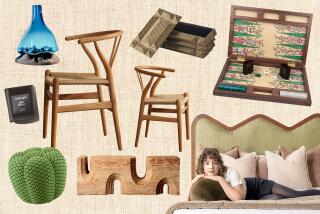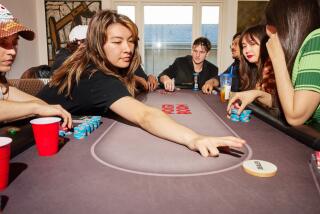Room Puts You Ahead of the Game : Furnishings: People are devoting entire areas to top-of-the-line ‘toys’ that are meant to entertain and attract the whole family.
- Share via
Say goodby to the shag carpeting and dark wood paneling. Arrivederci to the Ping-Pong table that always tilted to one side. Today’s game rooms (or bonus rooms as they’re sometimes called) have grown up and are showing off.
No longer used as a combination storeroom/TV room/den, people are actually furnishing game rooms with top-of-the-line “toys” to delight the whole family.
“I’m seeing more people devote an entire room to games,” said John Garcia of Planet Design Inc. in Corona del Mar. “The styles can vary widely from very sleek, sophisticated looks to a period style. It depends on the family and personal preferences.”
Garcia is currently working on a ‘50s diner-style game room, complete with a black and white checkerboard floor, jukebox and pool table.
“It’s a clever, nostalgic room,” he said. “I think when people are planning a game room they’re looking for something fun and unique.
“With this particular room, the owner wanted something that would be easy to maintain and very inviting. The chairs are on locking casters so they can roll around for ease, but be locked into place as well. There’s also storage for games and puzzles as well as a pool table, stereo system, the works.”
When people have the space they want to use it, according to Garcia. A game room provides a nice area for entertaining and doing something a little different.
“I think people are enjoying entertaining in their homes and this provides a fun environment for that,” he said. “It’s a comfortable, inviting place that’s cheery and a bit different.”
Even that old standby, the pool table, is getting a little spruced up.
“We’re doing pretty well despite the recession,” said Richard Johnson of Golden West Billiards in Orange. Johnson specializes in the sale of billiard tables and accessories, as well as other “game tables,” for such activities as poker, bumper pool and cards.
“I think there are two reasons people are buying tables,” Johnson said. “One is that playing pool is becoming more popular, and secondly, more people are staying home now. I guess they figure that if they forgo a trip or vacation, they’ll buy something everyone in the family can enjoy.”
And while Johnson does a good business selling used pool tables, more and more of his custom-made tables are getting attention.
“Most of the tables we sell are customized somehow,” he said. “It used to be that a pool table was green and green is still very popular. But now quite a few people want the table to match their decor. We also get calls from people who want us to replace the cloth on their tables.”
When Johnson started his business more than 20 years ago, the popular look was a dark, Spanish-influenced style. Over the years, customer preference moved toward the lighter woods, and now Johnson is seeing a return to the darker woods such as mahogany.
Currently, more than 40 different colors of cloth are offered, not to mention the various styles and finishes available. Styles of tables range from antique-looking models featuring dark woods and leather-fringed pockets to sleek, brass or chrome tables with hidden pockets.
“It all depends on what style you like,” Johnson said. “A lot of tables in the movies are antique styles with the lion’s head claw legs and darker woods. Other popular, contemporary tables are whitewashed or painted in pearl tones to match the paneling and woodwork you find in a lot of homes today.”
Some of the modern counterparts include those made of a synthetic material called abonite that’s frequently used around sinks and in kitchens. It has the look of marble or granite, but is more durable.
Pool tables, especially the custom-designed models, can be expensive.
Used tables generally sell from $700 to $2,500 (depending on the age, make and condition). New tables can cost up to $15,000. However, Johnson said, they tend to hold their value. Most tables are in the $2,000 to $3,000 price range. And, of course, once you’ve spent the money on a table, you’ll need a few extras to go with it. How about a custom-made cue rack? Today’s customers can choose from wall-mounted styles or ones that sit on the floor.
Pool lights are also required by most pool table owners.
“Tiffany-style lamps are still the most popular with our buyers,” said Johnson. “We do sell lighting fixtures with two or three globe-shaped bulbs but folks seem to prefer the old-fashioned, stained glass-type fixtures. These lamps are usually hung directly over the table for the best light.”
Pool tables can also be scaled down to fit. In fact, there are three different sizes: a 4 1/2-by-9-foot table (this size is usually found in pool halls), a 3 1/3-by-7-foot table (usually the size found in bars), and a 4-by-8-foot model (a mid-range model that’s usually found in homes).
“For a 3 1/2-by-7-foot table, you need to have a space of 13-by-16-feet to accommodate players and the cues,” said Johnson. “We call it ‘maneuvering room.’ ”
Johnson sells other game tables to people who come shopping for pool tables.
“We’re finding that more and more people are devoting entire rooms to games,” he said. “They have a pool table, a game table, perhaps a bar and a couple of stools and maybe a television or recording system. People spend a lot of time in there so they might as well enjoy it.”
Michael Egan of Laguna Beach has turned over a large portion of his home to games. A collector of vintage coin-operated machines, arcade games and pinball machines, Egan began his collection in one room, but it slowly began spreading to other rooms.
He’s not alone.
Antique arcade machines, jukeboxes and other memorabilia from bygone eras often end up in the game rooms of Orange County families.
“I don’t know if most people get as carried away as I do,” Egan said. “But there’s definitely an interest in these pieces. Most people start with one pinball machine and then gradually add to their collection. It’s not unusual to see several games and a jukebox in someone’s game room. I’d say pinball machines are getting quite popular. They’re an interesting alternative to video games.”
Like the pool tables, these items tend to increase in value as time goes on provided they’re in good condition.
Jukeboxes are also hot commodities, according to Garcia and Egan.
“People generally purchase jukeboxes from the era they grew up in, whether it’s the ‘30s, ‘40s or ‘50s,” said Egan.
Jukeboxes from the ‘30s and ‘40s (called “Golden Age”) are usually made of wood and play 75 r.p.m. records. About 20 records can be played.
After World War II, jukeboxes were fashioned of chrome or silver and played the 45 r.p.m. records. These “Silver Age” machines held up to 50 selections. Today’s jukeboxes hold up to 200 different selections. The average price for a wooden jukebox from the Golden Age is $6,000 to $9,000. A Silver Age piece runs from $2,000 to $5,000.
What is the attraction of jukeboxes, arcade games and other memorabilia?
“I think it makes people feel like they’re kids again,” Egan said.


